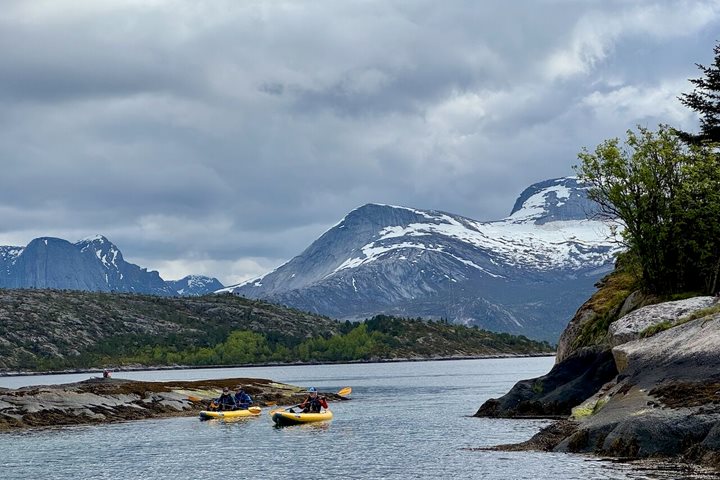After a smooth night of navigation from Bjørnøya we arrived off the southwestern tip of Spitsbergen Island in the Svalbard archipelago to clear blue skies, crisp Arctic air and a breathtaking coastline. By 7 a.m. we were well up the bight of Hornsund in a side arm called Burgerbukta. Our captain and expedition leader had determined through examining the satellite imagery and ice charts that remnant fast ice remained at the head of these inlets, clinging to the shore and rested up against the glacier faces.
This type of ice is crucial habitat for seals this time of year to haul out and rest. Where there are seals hauling out and fast ice, we often see polar bears (ursus maritimus), patrolling and hunting the remains of the winter ice. It wouldn’t be long that one of our naturalists on the bridge spotted a suspicious cream-colored speck on the sea of white. After closer inspection we had indeed found an “ice bear.” Not just one, but a female with two cubs of the year in tow. The margin of the fast ice was some three miles out from the glacier face and in order not to disturb this crucial habitat our captain slowly maneuvered us to the edge of the ice, closing the gap enough to clearly see the bears without disturbing them.
Within a few minutes of the first sighting another creamy figure was spotted about 2km from our family of bears. As it turns out it was another family of three bears; this time it appeared as if they were on a kill, likely a seal. With the bow of National Geographic Explorer nestled in the fast ice we all watched an interesting drama unfold. The threesome of bears that were first spotted and not on the kill made their way towards the kill and the other family. The female broke into a near full run leaving her cubs to catch up. As she drew nearer, the female bear that was busy feasting quickly retreated with her cubs, sprinting across the meter-or-so-thick ice with her cubs keeping pace. The intruding bear family proceeded to feed on the carcass contently. Minutes later the other female sauntered cautiously back to the kill site and drew within ten meters and appeared hopeful to regain her position on the kill. Seeing female bears and their cubs isn’t a common occurrence but two families of bears within one field of view is an exceptional opportunity. Both females and their cubs soon left the sight of the kill and went their separate ways on the fast ice.
The day was still young and before lunch, after having received our AECO briefing on policies and practices traveling in the Arctic, we were once again called to the decks and bridge with the sighting of another bruin. This time a lone, likely male, bear was feeding on a seal kill on the fast ice remaining in Samarinvagen. With the Samarinbreen Glacier as a backdrop we very slowly and quietly approached this content feeding bear, getting the ship close enough for good viewing but not too close to disturb it. We watched as it tore chunks of blubber and flesh from the seal carcass, stopping at times to clean its massive blood-stained paws. These bears derive nearly all of their nutrients from hunting seals and are exceptionally well suited to the task. In and around the islands of Svalbard it is this remaining winter fast ice that is not only so critical for the bears but also for their prey, the seals. We had seen several seals hauled out as we navigated this morning. Sadly, over the last few decades the extent and length of time that ice has persisted has diminished with each year.
By afternoon we sailed back towards the entrance to the main fjord of Hornsund in hopes to make our first landing at Gnålodden, or “Nagging Point,” named such for the raucous and busy seabird colony on Gnålberget. Near the shore an old trappers hut, dating back to the era of commercial trapping and hunting in the region, sits in good repair and is still occasionally used by researchers and travelers. The prominent face of Gnålberget towers over the landing site; swarms of kittiwakes and guillemot fill the skies as their calls echo out over the water.
After scanning the surroundings and a thorough examination of the landing for any sign of polar bears, we disembarked the ship and began exploring the areas around the landing. The weather remained very pleasant as small parties set off in many directions taking in the sights, sounds and crisp fresh air of the high Arctic. Hard to believe that just ten days ago we set out from bustling Copenhagen and have journeyed to this far-off place removed from civilization and home to the “ice bears.”






